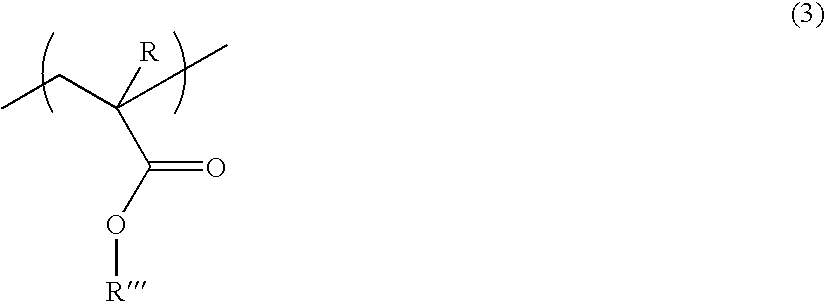Material for Forming Resist Protection Films and Method for Resist Pattern Formation with the Same
- Summary
- Abstract
- Description
- Claims
- Application Information
AI Technical Summary
Benefits of technology
Problems solved by technology
Method used
Image
Examples
example 1
[0085]The following resin component, acid generator, and nitrogen-containing organic compound were uniformly dissolved in an organic solvent to prepare a resist composition.
[0086]As the resin component, 100 parts by mass of a copolymer including a constituent unit represented by the following chemical formula (15) was used. The contents of the respective constituent units f, g and h used in the preparation of the resin component were respectively 40 mol %, 40 mol % and 20 mol %.
[0087]As the acid generator, 2.0 parts by mass of triphenylsulfonium nonafluorobutanesulfonate and 0.8 parts by mass of tri(tert-butylphenyl)sulfonium trifluoromethanesulfonate were used.
[0088]A mixed solvent of propylene glycol monomethyl ether and propylene glycol monomethyl ether acetate (mixing ratio: 6:4) was used as the organic solvent, to prepare 7.0% resist aqueous solution. As the nitrogen-containing organic compound, 0.25 parts by mass of triethanolamine was used. As the additive, 25 parts by mass o...
example 2
[0094]Using entirely the same procedure as the aforementioned Example 1, except that a composition containing a copolymer obtained in Manufacturing Example 1 shown in the above-described chemical formula (14) and 0.7% by mass (CF2)3(SO2)2NH based on the copolymer was used as the material for forming a protective film whose solid component concentration by mass was adjusted to 2.5% by mass, the number of pattern defects represented by bridges, etc. was measured three times respectively to obtain mean values thereof.
[0095]Results obtained are shown in the following Table 1 as ratios relative to 100 defects obtained in the comparative example 1 described below.
example 3
[0096]Using entirely the same procedure as the aforementioned Example 1, except that a composition containing a copolymer obtained in Manufacturing Example 1 shown in the above-described chemical formula (14) and 0.7% by mass (CF2)3(SO2)2NH based on the copolymer and 0.7% by mass tetrabutoxymethylated glycoluryl based on the copolymer was used as the material for forming a protective film whose solid component concentration by mass was adjusted to 2.5% by mass, the number of pattern defects represented by bridges, etc. was measured three times respectively to obtain mean values thereof. Results obtained are shown in the following Table 1.
PUM
| Property | Measurement | Unit |
|---|---|---|
| Contact angle | aaaaa | aaaaa |
| Fraction | aaaaa | aaaaa |
| Fraction | aaaaa | aaaaa |
Abstract
Description
Claims
Application Information
 Login to View More
Login to View More - R&D
- Intellectual Property
- Life Sciences
- Materials
- Tech Scout
- Unparalleled Data Quality
- Higher Quality Content
- 60% Fewer Hallucinations
Browse by: Latest US Patents, China's latest patents, Technical Efficacy Thesaurus, Application Domain, Technology Topic, Popular Technical Reports.
© 2025 PatSnap. All rights reserved.Legal|Privacy policy|Modern Slavery Act Transparency Statement|Sitemap|About US| Contact US: help@patsnap.com



